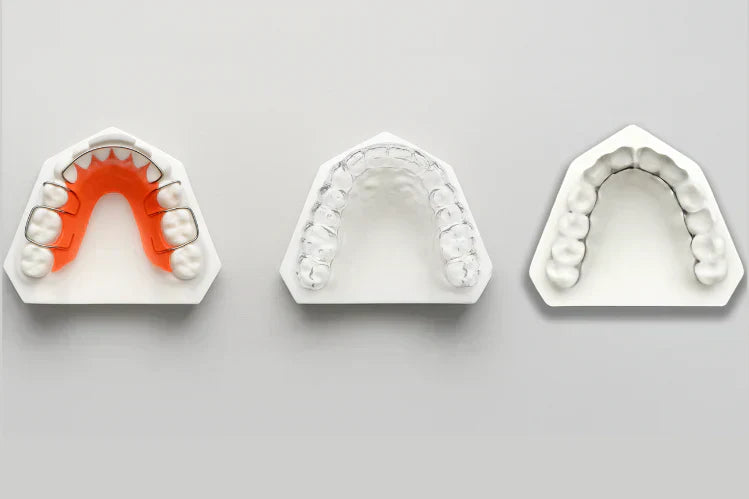
Table of Contents
- What Are Retainers?
- Why Do You Need a Retainer?
- Purpose of Retainers
- Different Types of Retainers
- Why Teeth Can Shift after Braces
- How Long to Wear Retainers after Braces?
- What to Expect after Braces: Life with a Retainer
- What Happens If You Don’t Wear Your Retainer?
- Retainer Care Tips
- Smilepath Retainers
- Final Takeaway: Retainers Are a Must
- FAQs
Have you recently gotten your teeth aligned with braces or aligners?
Congratulations on achieving the smile of your dreams. Straightening your teeth is a serious commitment, and completing it is no small feat. But just because your teeth are aligned, it doesn’t mean your journey to a lasting, straight smile is over. That’s where retainers come into play.
You might be wondering: What’s the point of teeth retainers? Why are they necessary after braces? How long do you have to wear them? Let’s break it all down and explain why retainers are key to keeping that smile you worked so hard for.
What Are Retainers?
Teeth retainers are orthodontic devices, either removable or fixed, that are used to keep your teeth in place after braces or aligners. They’re usually made from plastic, metal wires, or both. Once the braces come off, the retainer steps in to prevent your teeth from shifting back to their original position.
Think of your retainer as the final step in your orthodontic treatment. It doesn’t move your teeth, it holds them exactly where they need to be.
Why Do You Need a Retainer?
So, why is a retainer so important after all that dental work?
When braces or aligners shift your teeth into the right position, your gums and jawbone need some time to get used to the new positioning. Without a retainer, your teeth can gradually slide back, a process called orthodontic relapse . However, a retainer helps to prevent such a situation.
Purpose of Retainers
Stabilizing Your Bite
Even after braces come off, your teeth and jaw are still settling. Retainers help things stay in place.
Preventing Relapse
Without a retainer, your teeth could slowly shift back over time.
Helping Bone and Tissue Adapt
Your gums and bones need time to mold around the new tooth positions.
Keeping Your Smile for Life
In many cases, you’ll need to wear a retainer (at least at night) indefinitely.
Different Types of Retainers
There are three types of dental retainers—each with its pros and cons.
Hawley Retainers
These are the classic ones made with acrylic and metal wire. They sit over your teeth and are typically used for the upper arch.
Pros
- Long-lasting and sturdy
- Can be adjusted slightly to refine tooth position
- Let the upper and lower teeth meet naturally
Cons
- They’re visible
- It may feel a bit bulky at first
Clear Plastic Retainers
Clear teeth retainers, also known as Essix retainers, are similar in appearance to clear aligners and are barely visible when worn.
Pros
- Nearly invisible
- Comfortable and snug
- Easy to wear
Cons
- Can warp if exposed to heat
- Less durable than Hawley retainers
- Require good care to last
Permanent (Bonded) Retainers
These are wires attached to the back of your teeth—usually the lower front—and aren’t removable.
Pros
- Always in place—no chance of forgetting them
- Hidden from view
- Great for preventing relapse
Cons
- Harder to clean around
- Can come loose or break
- Require regular monitoring by your dentist
Why Teeth Can Shift after Braces
It’s a common misconception that your teeth will stay put once braces are off. In reality, teeth are constantly under pressure from chewing, speaking, and even how you sleep. Without a retainer, your teeth can easily start to move again.
This is especially true right after your treatment ends, which is why your dentist will strongly emphasize wearing your retainer.
Some reasons your teeth might move post-treatment:
- Natural jaw changes as you age
- Ongoing growth (especially for younger patients)
- Teeth grinding or clenching
- Not wearing your retainer consistently
How Long to Wear Retainers after Braces?
Every case is unique, so always follow your dentist's instructions on retainer wear. However, here’s a rough timeline:
First 0–6 Months
Wear your retainer full-time (20–22 hours a day). Only take it out for meals or cleaning.
6 Months to 1 Year
Most dentists recommend wearing it only at night.
1 Year and Beyond
Continue wearing it a few nights a week, ideally, for life.
What to Expect after Braces: Life with a Retainer
Once the braces are off, your dentist will take molds of your teeth to create your retainer. Here’s what might happen:
- Some tightness or discomfort as your teeth settle.
- Minor changes in speech, especially if you have a removable retainer.
- A cleaning routine—daily care is important to keep the retainer fresh and functional.
- Follow-up visits to check the fit and make sure it’s working properly.
If your retainer doesn’t fit quite right, don’t wait—get in touch with your dentist quickly to prevent shifting.
What Happens If You Don’t Wear Your Retainer?
You might think skipping a few nights isn’t a big deal. But in reality, your teeth can start to move pretty quickly, sometimes in just a few days.
Here’s what could happen:
- Crowding comes back, especially in the lower front teeth.
- Spacing or bite issues return.
- Your bite may become misaligned, possibly leading to jaw pain.
- You may need orthodontic treatment again, which isn’t cheap.
Retainer Care Tips
Want your retainer to last and keep doing its job? Here’s how to take care of it:
Dos
- Rinse it after every use
- Brush it gently with a soft toothbrush and mild soap
- Keep it in its case when not in use
- Keep it away from heat (hot water, cars, etc.)
Don’t
- Use toothpaste (it can scratch plastic retainers)
- Wrap it in napkins (easy to accidentally throw out)
- Let pets near it (they’d love to chew on them)
- Skip wearing it unless your dentist says it’s okay
Smilepath Retainers

In addition to a hassle-free teeth straightening process, Smilepath offers clear retainers . Retain your newly achieved smile in the best possible way. Our clear retainers are composed of BPA-free plastic material and are customized to each individual’s dental structure. It helps to provide a snug fit and prevent your teeth from shifting back to their original position.
Final Takeaway: Retainers Are a Must
Retainers may seem like a minor afterthought, but they’re one of the most important parts of your orthodontic treatment. They hold all that hard work in place.
- Retainers keep your teeth aligned after braces.
- There are several types, each with unique advantages.
- Wearing them consistently is the only way to avoid relapse.
- Plan on wearing them at night—ideally, forever.
Skipping retainers could undo years of effort and investment. But staying on top of your retainer game will keep your smile looking great for life.
FAQs
After getting your teeth aligned, there is a chance of an orthodontic relapse. To prevent your teeth from shifting back to their original position, it is important to wear retainers.
The different types of retainers include: Hawley, Clear, and Fixed. You can choose the type of retainer that best suits your lifestyle and case severity.
Initially, you might have to wear retainers throughout the day. However, over time, the duration may shift to nighttime wear only.
Citations:
American Association of Orthodontists. Multiple pages reviewed. Will I Need to Wear Retainers After Treatment? (https://www.aaoinfo.org/blog/will-i-need-to-wear-retainers/) Accessed 8/25/2022.
Dentaly.org. Teeth Retainers: What’s the Best Type? Hawley, Essix, and More (https://www.dentaly.org/us/adult-braces/teeth-retainers/). Accessed 8/25/2022.
Health Direct. Dental braces and retainers (https://www.healthdirect.gov.au/dental-braces-and-retainers). Accessed 8/25/2022.
NHS. Orthodontic treatments (https://www.nhs.uk/conditions/orthodontics/treatments/). Accessed 8/25/2022.
Professional, C. C. M. (2025l, March 19). Teeth Retainer. Cleveland Clinic. https://my.clevelandclinic.org/health/treatments/10899-teeth-retainer







 Australia
Australia New Zealand
New Zealand Malaysia
Malaysia English
English Portuguese
Portuguese English
English English
English English
English English
English English
English Canada
Canada